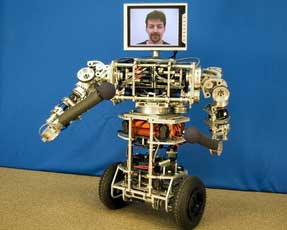Researchers at the University of Massachusetts Amherst have developed a robotic assistant that can provide help for the elderly.
Not only can it dial the emergency services, it can remind clients to take their medication, help with grocery shopping and allow a person to talk to loved ones and carers.
Concerned family members can access the unit and ’visit’ their elderly parents from any internet connected PC. They can also navigate the robot around the home to looking for relatives who may not hear a phone ringing, or be in need of assistance. Doctors can also perform ’virtual’ house calls, reducing the need for travel.
’For the first time, robots are safe enough and inexpensive enough to do meaningful work in a residential environment,’ said computer scientist Rod Grupen, director of UMass Amherst’s Laboratory for Perceptual Robotics, who developed the robot with computer scientists Allen Hanson and Edward Riseman.
There is no mistaking the so-called uBot-5 for a person, but its design was inspired by human anatomy. An array of sensors acts as the robots eyes and ears, allowing it to recognise human activities, such as walking or sitting. It can also recognise an abnormal event, such as a fall, and notify a carer. The carer can then ask the client to speak, smile or raise both arms. If the person is unresponsive, the robot can then call the emergency services, alert family and apply a digital stethoscope to a patient, conveying information to an emergency medical technician who is en route.
The robot can also track what isn’t human. If a delivery person leaves a package in a hallway, it notices when a path is blocked and can move the obstruction out of the way. It also has the potential to perform household tasks that require a fair amount of dexterity, including cleaning.

The uBOT-5 carries a Web cam, a microphone, and a touch-sensitive LCD display. ’Grandma can take the robot’s hand, lead it out into the garden and have a virtual visit with a grandchild who is living on the opposite coast,’ said Grupen.
Grupen studied developmental neurology in his quest to create a robot that could do a variety of tasks in different environments. The uBot-5’s arm motors are analogous to the muscles and joints in our own arms, and it can push itself up to a vertical position if it falls over. It has a ’spinal cord’ and the equivalent of an inner ear to keep it balanced on its Segway-like wheels.




Poll: Should the UK’s railways be renationalised?
Presumably the political fallout would be that the rail users would complain that they were being taxed unfairly to subsidise the people going about...